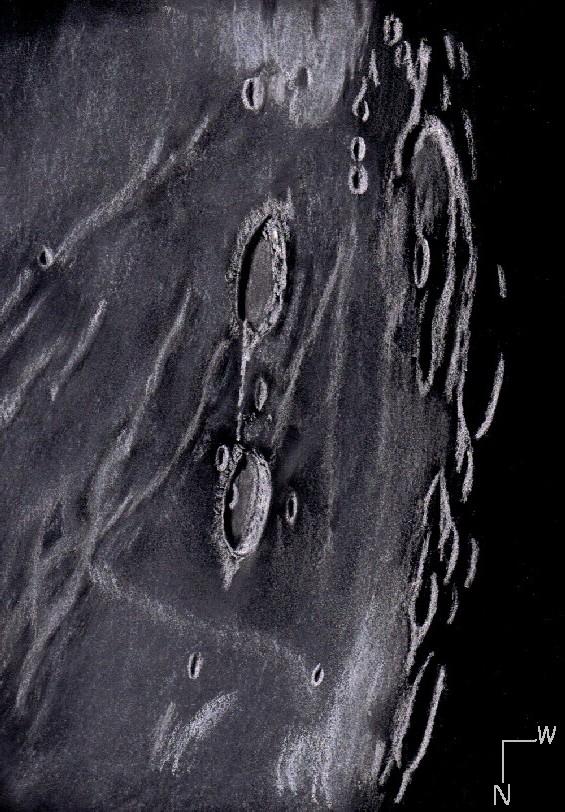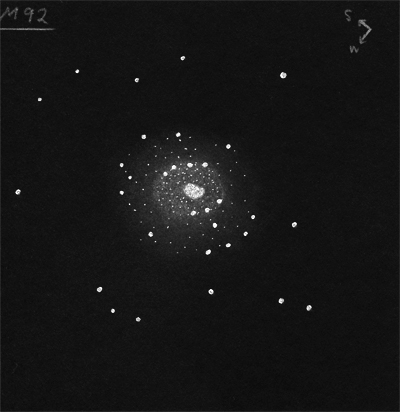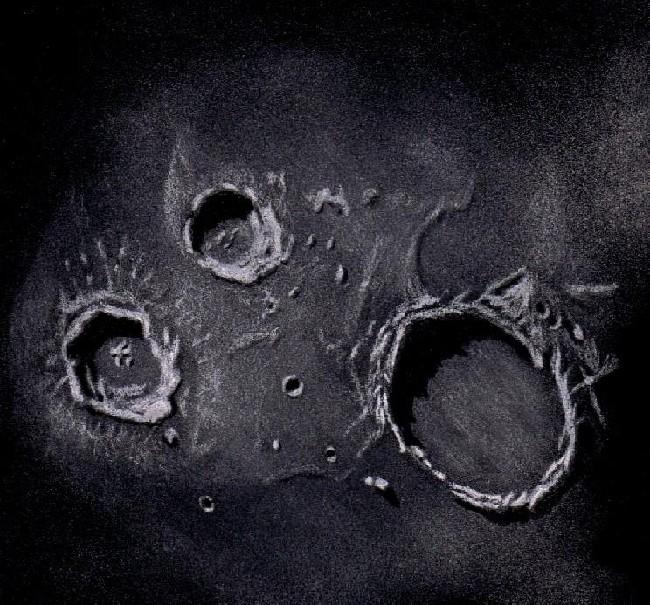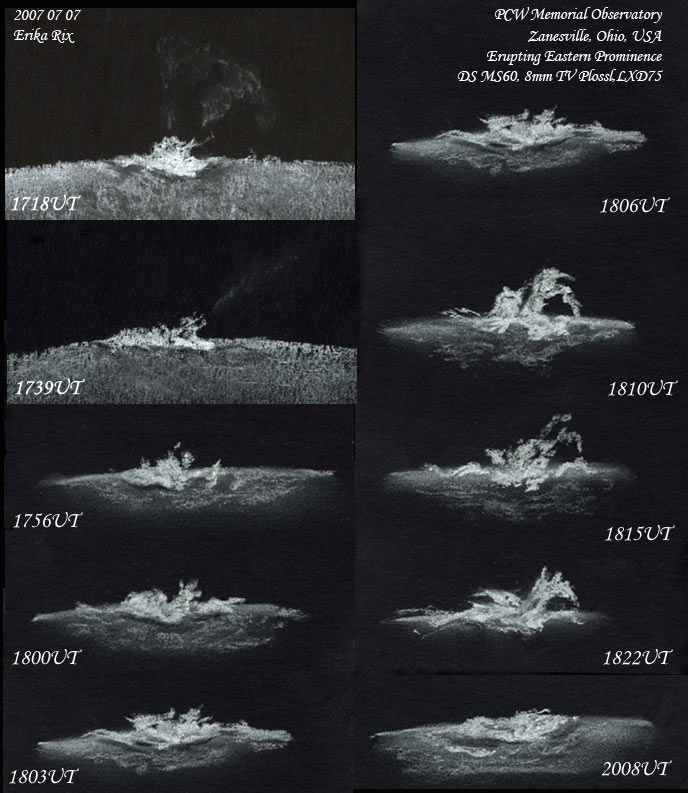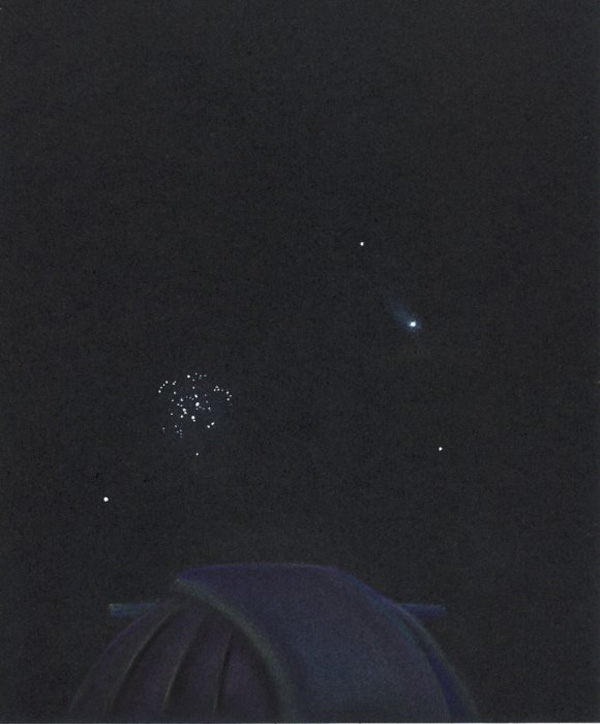With high pressure moving into my observing area, there was a good chance that the
cloud cover would break up and move out before local midnight. Eventually it did.
The nearly full moon hung low and large in the sky to the south. The largest mare
on the lunar surface is the Ocean of Storms. A pair of similar looking, north to
south oriented craters at the western extreme of the Ocean of Storms is linked to
each other by a rille-like chain of craters. The southern most crater of the pair
is the 50 km. diameter Cardanus. This crater was demonstrating its terraced walls
and hilly irregular ramparts in the low altitude sunlight. Following the catena
southward for a little more than 60 km. we arrive at the other member of the pair
named Krafft. Like Cardanus crater Krafft (51 km.) has in addition to the features
of the former, a crater of 13 km off set from the center of the floor. The sun was
high enough to illuminate much of the impact debris of the region in the form of
numerous crater rays. Closer to both the terminator and limb of the moon in the
libration zone larger craters Vasco de Gama and Dalton are making their appearances
from the long lunar night.
Sketching:
For this sketch I used: black Strathmore 400 Artagain paper, white and black Conte’
pastel pencils and a blending stump. Contrast was slightly increased after scanning.
Telescope: 10 inch f/ 5.7 Dobsonian and 6 mm eyepiece 241X
Date: 7-29-2007, 3:10-4:30 UT
Temperature: 23° C (74° F)
Partly cloudy, calm
Seeing: Antoniadi III
Colongitude 83.6 °
Lunation 14.6 days
Illumination 99 %
Libration long. -4.7°
Frank McCabe
Category: Media Combinations
The Lost Treasure of Hercules
Messier 92: Globular Cluster
And yet, another one of those Globs – don’t worry, there are plenty, 29
in the Messier Catalog alone, but I am slowly pulling through, one more
down on the list and counting. All in all, I’d say: again not bad, measured
up to the years of life it cost me to draw it. You sit there at the telescope,
frozen to the spot in a never-ending struggle to decide, whether you’ve
seen the detail or not, whether you should draw it or not, your hands are
getting cold, your neck is getting stiff and the cluster simply keeps refusing
to turn out the way you want it or see it. Well, the longest journey comes to
an end, so here it is: M 92! I like to call it The Lost Treasure of Hercules,
because it is a great view, yet often overlooked due to its proximity to the
far more well-known M 13. Maybe next time you visit the area, remember to
make a little stop-over at M 92.
Date: April 15, 2007
Location: Kegelhaus, Erbendorf, Bavaria, Germany
Instrument: Dobsonian 8″ f/6
Constellation: Hercules
Seeing: II of VI
Transparency: I-II of VI
NELM: 6m2
Magnification: 133x
Technique: white pastel pens and white ink-pen on black cardboard
Sebastian Lehner
Center of the Lunar Nearside
When the moon is several degrees below the summer ecliptic to the south, it can be
challenging to view and sketch from mid-northern latitudes.
I chose for sketching a highland region inside the triad of the Bays of Medii and
Aestuum and the Sea of Vapors. The center of this region contains the crater pair
Pallas and Murchison. Crater Pallas (50km.) which is a Nectarian period formation
is more than 3.8 billion years old. Pallas has a partially buried central peak at
1.3 km. above the lava flooded floor. Crater Pallas-A rests on the western rim and
deep bowl shaped crater Bode beyond the rim are clearly seen. Murchison (58 km.)
which is the oldest of the pair at about 4 billion years shows the greatest amount
of wear. Lava flooded floor, severe wall erosion, and strikes such as Chladni
(13.8km.) on the southeastern wall are among the features that demonstrate the age
of this crater. All that remains of the common wall of Pallas-Murchison are pieces
of ridge wall. Half of well known crater Triesnecker is visible to the east.
I was unable to use higher magnification because sky conditions were below average
until after moonset.
Sketching:
For this sketch I used: black Strathmore 400 Artagain paper, white and black Conte’
pastel pencils and a blending stump. Contrast and brightness were slightly
increased after scanning.
Telescope: 10 inch f/ 5.7 Dobsonian and 9 mm eyepiece 161X
Date: 7-23-2007, 1:15-1:48 UT
Temperature: 24° C (75° F)
Partly cloudy, calm
Seeing: Antoniadi III
Colongitude 10.1 °
Lunation 8.6 days
Illumination 58 %
Frank McCabe
Three near the seashore
Archimedes et. al.
Finally, I was blessed with a clear sky. It has been 26 days since the beginning of the year and this is my fourth clear or mostly clear night. With the moon well into lunation 1040, it was bright and high in the sky at nightfall. After observing the lunar surface for about forty-five minutes, I selected a favorite region in eastern Mare Imbrium for sketching.
As an eighth grader with a new 4.25 inch f/10 Newtonian telescope, Archimedes was the first crater I remember identifying with this scope. I selected my 10 inch f/ 5.7 Dobsonian and 6mm eyepiece to make my sketch of this region. In the sketch below the three craters in counterclockwise direction from smallest to largest are: Autolycus, Aristillus and Archimedes. About half way between Autolycus and Archimedes is the impact site of the first spacecraft to reach the moon September 14, 1959. It was Luna 2 and after crossing through the Van Allen belt it detected and confirmed the solar ions known as the solar wind particles just prior to its lunar rendezvous.
The two smaller craters are from the Copernican period and the larger crater Archimedes is an ancient crater that dates back beyond 3 billion years ago. The terraced walls of Archimedes stand 2000 meters above the flat lava flooded floor of this crater. I was unable to detect at this observation any of the craterlets on the floor. This crater is 85 km. across. Autolycus is less than half the diameter of Archimedes has a higher rim (3000 meters) and an irregular floor. Aristillus which is intermediate in size (56 km diameter) has the tallest rim at 3500 meters and 3 mountains on its floor up to 900 meters tall.
For this sketch I used: black Strathmore 400 Artagain paper, white and black Conte’
pastel pencils and a soft piece of leather for blending. Image was slightly darkened using Imageenhance software.
Date 1-27-2007 1:10-2:40 UT
Temperature: 3.8° C (39° F)
Windy with strong gusting
Seeing average Antoniadi: III
Colongitude: 10.5 °
Lunation: 7.9 days
Illumination: 62.3 %
Frank McCabe
Lights Out for Eratosthenes
At the southern end of the lunar Apennines on the border between the Bay of
Billows (mostly in darkness) and Sea of Rains lies 60 km. crater Eratosthenes. I
was off and on observing over most of the night. By morning twilight when the moon
was high in the east, Eratosthenes crater was experiencing sunset. The deep, dark
caldera-like aperture was undergoing sunset at the beginning of my sketch. This
3.2 billion year old land mark crater is the defining feature of the Eratosthenes
time period. While sketching I could clearly see much of the ejecta pitting of
Copernicus and its ray material which crossed the region 2 billion years after
Eratosthenes formed. I did not include much of the Copernicus crater impact
features because they are in my opinion more suitable for high resolution
photography or direct visual examination at high power. In this sketch I tried to
briefly capture the overall eyepiece view.
Sketching:
For this sketch I used: black Strathmore 400 Artagain paper, white and black Conte’
pastel pencils and a blending stump. Contrast was slightly increased after scanning.
Telescope: 10 inch f/ 5.7 Dobsonian and 6 mm eyepiece 241X
Date: 7-8-2007, 9:15-10:30 UT
Temperature: 22° C (73° F)
Clear to partly cloudy, light winds
Seeing: Antoniadi II
Colongitude 190.2 °
Lunation 23.25 days
Illumination 42.2 %
Frank McCabe
Splash in the water
This erupting prominence sequence reminded me of a rock plopping in the water. It
was brilliant to watch. This observing session nearly made me late for my brother’s
wedding, but I just couldn’t tear my eyes away from the view to to give myself ample
time to look presentable for the special occasion. As a last minute idea to add to
their wedding present, I framed the first sketch of this sequence with the date for
them….starting their new lives together with a bang, so to speak. Number 963 for
the sun, day one for my brother and his new wife. Sketches done with black
Strathmore paper and white Conte’ crayon.
Erika Rix
Zanesville, Ohio
This is a link to an animated sequence of the same session that Erika produced herself!
Cleomedes in the Waning Light
Just north of Mare Crisium and formed during the Nectarian period more than 3.7
billion years ago is the 128 km. walled plain crater Cleomedes. This crater has a
high but worn margin and was nicely catching the last rays of sunlight overnight.
The large flat floor may have been flooded by lava that reached the crater floor
through fractures from the molten lava of Mare Crisium. What remains of the
central peak is a low wall oriented north-south and somewhat off center. A hint of
60 km. long ‘y’ shaped Rima Cleomedes was just detectable north of the central
wall running off to the southeast. To the northwest of Cleomedes is 57 km. crater
Burckhardt straddled by its close partners E and F. To the east of Cleomedes is
crater Delmotte (32 km.) and off to the northwest is crater Tralles (43 km.)
hugging the rim. On the floor from north to south are A and larger E which
together damaged the wall of Cleomedes upon formation. Crater B can be seen
south of the central wall and then J to the southeast on the floor. Resting on the
south rim is crater C. This region of the lunar surface was fascinating to observe
in this part of the lunation.
Sketching:
For this sketch I used: black Strathmore 400 Artagain paper, white and black Conte’
pastel pencils and a blending stump. Contrast was slightly increased after scanning.
Telescope: 10 inch f/ 5.7 Dobsonian and 6 mm eyepiece 241X
Date: 7-2-2007, 4:10-5:30 UT
Temperature: 18° C (65° F)
Clear, light winds
Seeing: Antoniadi II
Colongitude 116.6 °
Lunation 17.25 days
Illumination 96.4 %
Frank McCabe
Two great philosophers meet on the Moon
Aristoteles and Eudoxus
Warm moist air from the south and cool dryer air from the north have been battling it out over the Chicago area for the last week. This morning the cold air was winning as the thermometer in my yard was reading 47°F. Fortunately the cold high pressure air mass was accompanied by better than average seeing and transparency.
The 20 day old waning gibbous moon was about 30° above the southern horizon at an hour and a half before sunrise. For sketching targets I chose Aristoteles and Eudoxus along the northern terminator. The view in my 10” f/5.7 Newtonian held up well at both 241X and 362X. I sketched at the eyepiece using both magnifications. Twin peaks on the floor of Aristotles were visible with the southeastern most peak surrounded by shadow. This 90 km Eratosthenian crater was displaying nicely terraced wall on the steep eastern side. Off to the terminator side (east) and overlapped by Aristoteles is the shadowed floor crater Mitchell (31 km.) an older Imbrian formation. Further north along the terminator margin is rim illuminated crater Galle which stretches 22 km in diameter and is about the same age as Aristoteles. The other large and younger crater to the south is Eudoxus (70 km.) which also has steep terraced walls. A small part of the Caucasus mountain range can be seen west and southwest of Eudoxus. Due west of Aristoteles the ancient eroded ghost-like crater Egede at 37 km in diameter can be seen in contrast to the younger craters named above.
Sketching:
For this sketch I used: black Strathmore 400 Artagain paper, white and black Conte’ pastel pencils and a blending stump. Brightness was slightly decreased after scanning.
Telescope: 10 inch f/ 5.7 Dobsonian and 6 and 4 mm eyepiece 241 and 362X
Date: 6-6-2007 9:05-10:00 UT
Temperature: 8° C (47° F)
Clear, calm
Seeing: Antoniadi II-III
Colongitude: 158.7 °
Lunation: 20.6 days
Illumination: 72.7 %
Frank McCabe
One prom times twelve
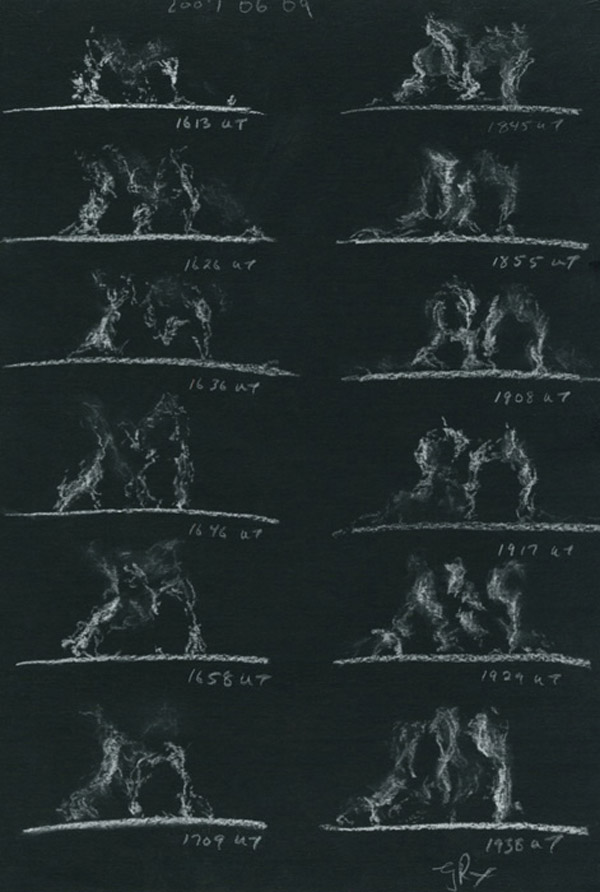
The flare activity this morning (June 9th, 2007) had pretty much subsided by the time my session took place. Yes, I was disappointed, but AR0960 was still showy
with AR0959 accessorizing it nicely. There was a thin little plage
marking 959 as well as plage just East of the center of the disk, and
plage also very thinly following the path of a long slender filament just
inside the Eastern limb. Add the remarkable plage details in AR0960 to
that, and you have a straight line of interrupted plage going from East to
West.
The two spots within 960 were easy to spot as black dots. There was a
third dot just North of them that I first thought was another spot to that
region. But I’m pretty sure it was a little piece of filament having
compared my sketches to other images afterward.
When tuning, I could easily pick out several other filaments across the
disk even though they were very slender and short, almost like little
crooked crosshairs of an eyepiece. There were five definite prominences
with a few little hints of others on the limb. The huge prominence that
was evident on the NW limb earlier this morning was no longer there that I
could see. However, the “pick of my pleasure” prominence was the presence
of an “m” shaped faint one on the NE limb. And this, my friends, became
the start of a three and a half hour project for me today. It made no
matter that I had lots of chores to do. Astronomy comes first…at least
today.
The series for this one prom was rendered in two sessions. An hour with 1
minute intervals, an hour and a half break so that I could at least get
the riding mower part of the grass cutting done, and then another hour
session with 10 minute intervals again. I would have loved to spend the
entire day doing this, but I was starting to get sunburn on my farmer’s
tan legs and feet that today sported sandals instead of sneakers.
Nevertheless, perhaps 12 sketches of the same prominence were enough to
show how dynamic the Sun is over such a short period of time. Or could I
have really stopped because I didn’t want to be known as the eccentric
prom lady that latched on to only one prom, sketching it over and over
again with a strange fixation…you can chose, if you like.
Sketches were done with black Strathmore paper and colored Conte’ crayons
for the full disk, white Conte’ for the prominence sequence.
Erika Rix
Zanesville, Ohio
This is a delightful video version of full disk and the prom sequence sketches that Erika created: http://www.photoshow.com/watch/gA4ky6wN check it out!
Of cloisters, comets and clusters
Back in the late spring of 2004 I had the opportunity to attend an astronomy
evening at the old Royal Greenwich Observatory (RGO) at Herstmonceux in
Sussex, England. The weather was dreadful, stormy and rainy, when the
evening began, but by the time the lecture had finished the skies were
clearing rapidly and we were able to catch sight of Comet C/2001 Q4 (NEAT),
a fleeting visitor gracing the region of the ‘Beehive’ cluster (M44) at this
time. The comet was just visible as a naked eye object, but binoculars gave
the best view. This is a reworked pastel and acrylic sketch from my
original, very hastily scribbled graphite binocular sketch. One of the
distinctive copper observatory domes provides foreground interest.
Sketch details:
10 x 50 Zeiss binoculars
16th May 2004, 23.05 UT
RGO, Herstmonceux, Sussex, England
Coloured and white chalk pastel (plus white acrylic for the cometary nucleus
and star images) on black Canford card
Sketch size 8″ x 10″
Sally Russell
Berkshire, England

